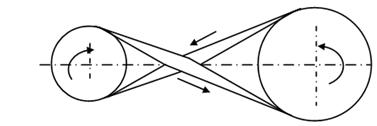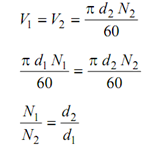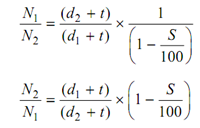Cross Belt Drive:
In cross belt drive, the pulleys rotate in the opposite direction. The angle of contact of belt on both of the pulleys is equivalent. This drive is illustrated in Figure. As illustrated in the figure, the belt needs to bend in two different planes. As a consequence of this, belt wears very fast and thus, this kind of drive is not preferred for power transmission.

As power transmitted by a belt drive is because of the friction, this kind of drive is subjected to slip and creep.
Assume d1 and d2 be the diameters of driving and driven pulleys. N1 & N2 is respectively the corresponding speeds of driving and driven pulleys.
The velocity of the belt passing over the driver

If there is no slip among the belt & pulley

If thickness of the belt is't', the velocity ratio is

Assume there by total percentage slip 'S' in the belt drive shall be as follows :

The belt moves from the tight side to the slack side and vice-versa, there is some loss of power due to the length of belt continuously extends and contracts and hence, there is relative motion among the belt and pulley. This is known as creep.